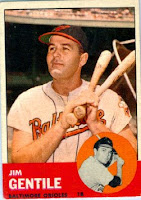While Billy Rowell's individual statistics aren't where he'd like them to be, the 2006 Bishop Eustace Prep graduate isn't ready to fold the tent. In fact, Rowell is as focused today on improving as a professional baseball player as he was when he arrived early to spring training.More after the jump.
"You can't get frustrated because you're not putting up the kind of numbers you want," said Rowell, who was taken by the Baltimore Orioles with the ninth overall pick in the 2006 draft. "All you can do is work harder and hope something clicks. You can't get down on yourself. That doesn't help the situation.
"I definitely see improvements. They may not be number-wise, but I've hit a few more homers and I'm getting experience and seeing how pitchers are pitching me."
Past Roar from 34 postings about Rowell:
The Local Angle on Billy Rowell
Checking in on Billy the Kid
"O"dds and Ends: A Collection of Orioles News
The O's on Deck rundown on Rowell:
Predict the future -- Bill Rowell










